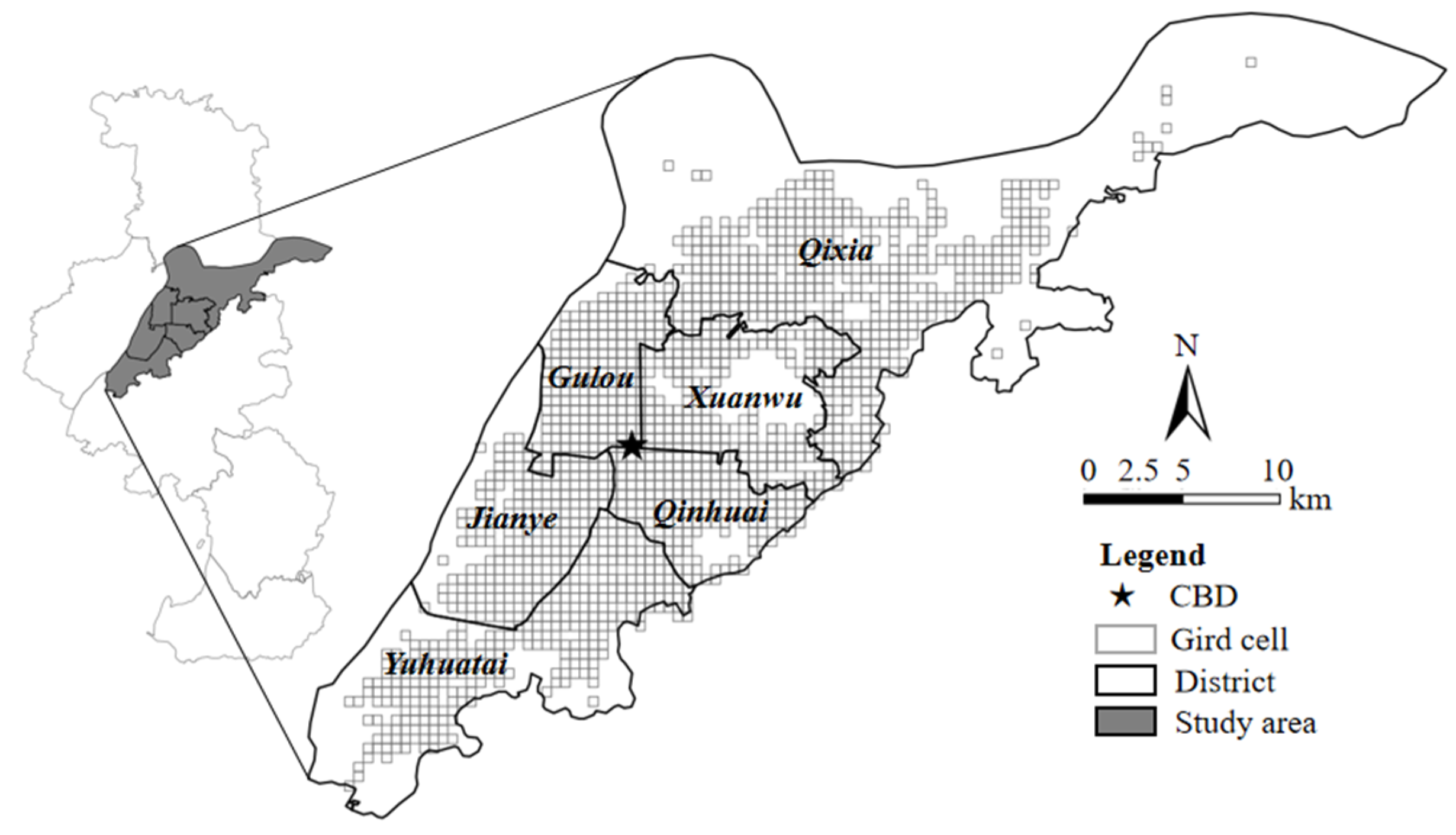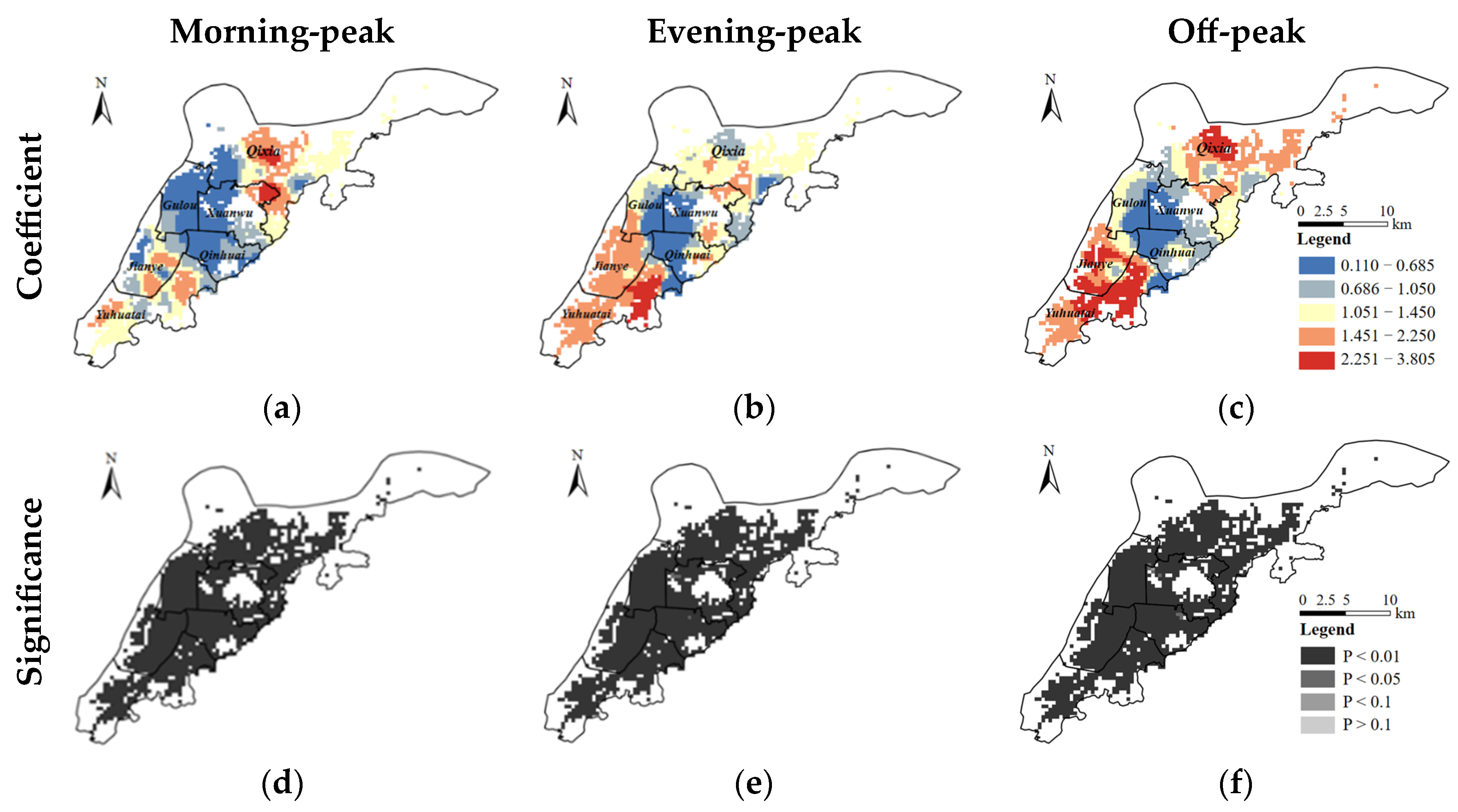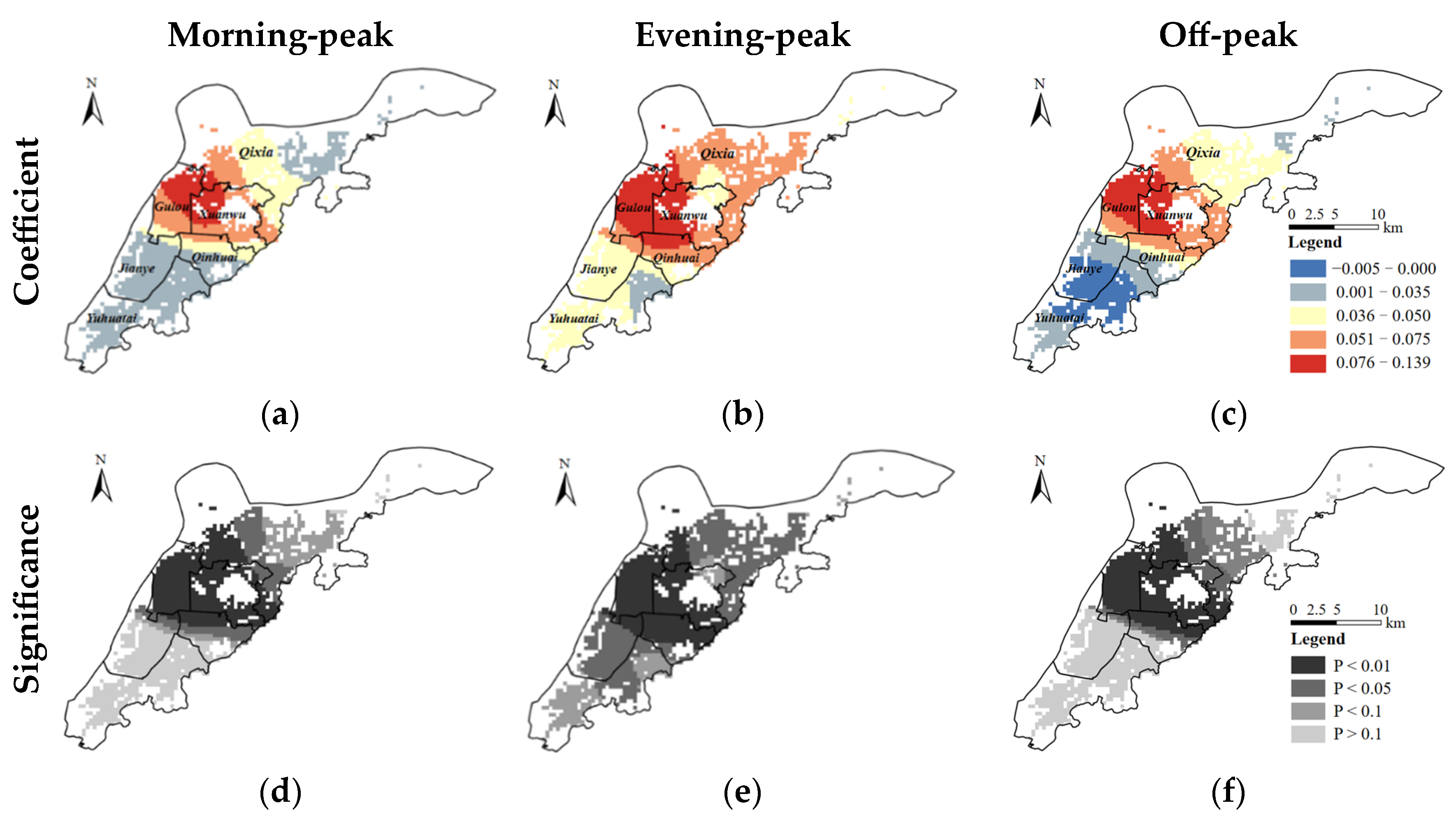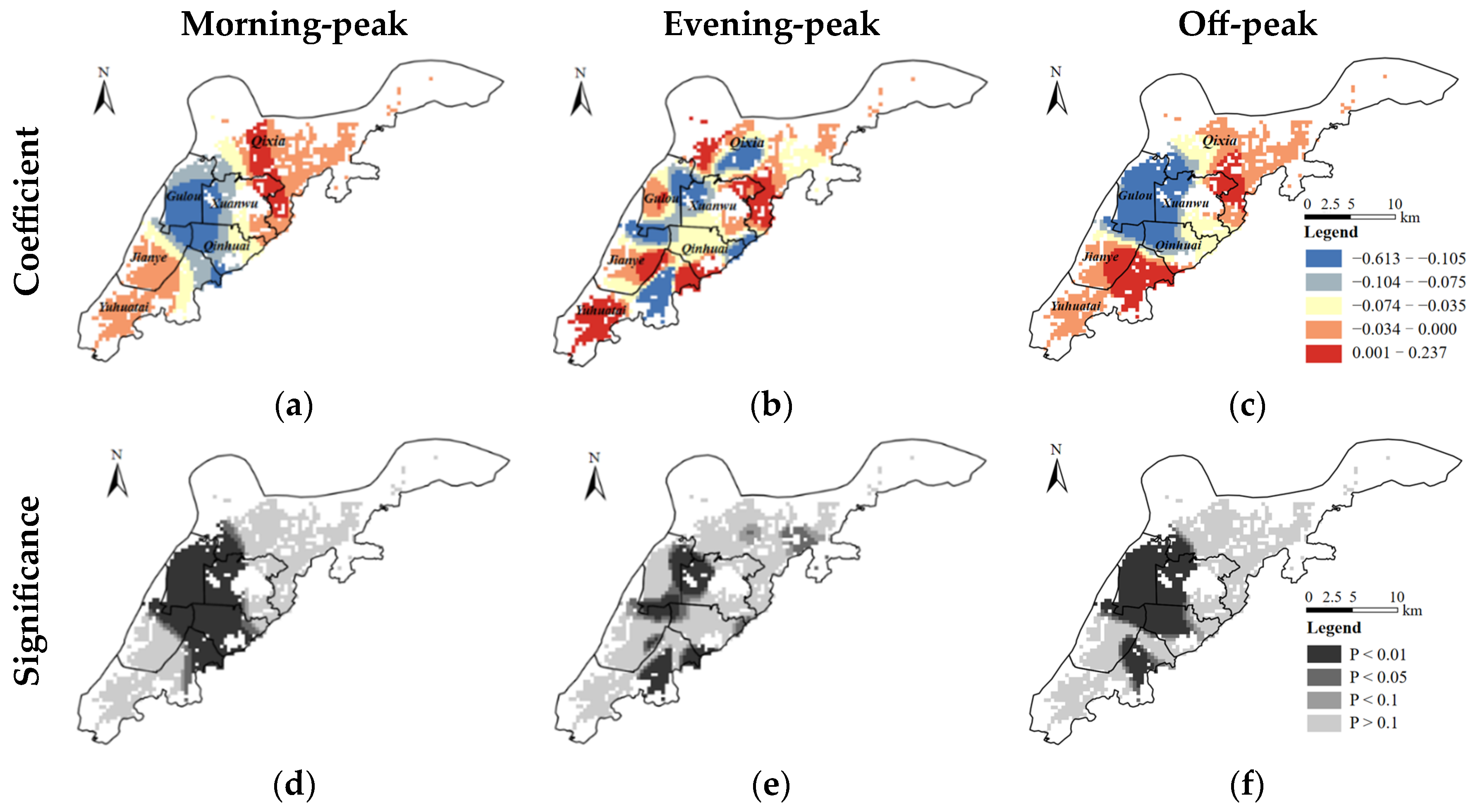Spatiotemporal Heterogeneous Effects of Built Environment and Taxi Demand on Ride-Hailing Ridership
Abstract
:1. Introduction
2. Literature Review
2.1. Understanding Ride-Hailing Ridership with Different Data Sources
2.2. Built Environment Effects on Ride-Hailing Ridership
3. Methodology
3.1. Study Area and Data
3.2. Modeling Approach
- (1)
- Ordinary least squares (OLS)
- (2)
- GWR
- (3)
- MGWR
4. Results
4.1. Model Comparison
4.2. Regression Coefficients of MGWR
4.3. Spatiotemporal Variations in the Effects on Ride-Hailing Ridership
5. Concluding Remarks
Author Contributions
Funding
Institutional Review Board Statement
Informed Consent Statement
Data Availability Statement
Acknowledgments
Conflicts of Interest
References
- Wang, S.; Noland, R.B. Variation in ride-hailing trips in Chengdu, China. Transp. Res. Part D Transp. Environ. 2021, 90, 102596. [Google Scholar] [CrossRef]
- Liu, F.; Gao, F.; Yang, L.; Han, C.; Hao, W.; Tang, J. Exploring the spatially heterogeneous effect of the built environment on ride-hailing travel demand: A geographically weighted quantile regression model. Travel Behav. Soc. 2022, 29, 22–33. [Google Scholar] [CrossRef]
- The Online Car-Hailing Supervision Information Interaction System Released the Basic Operation of the Online Car-Hailing Industry in May 2023. Available online: https://www.mot.gov.cn/fenxigongbao/yunlifenxi/202306/t20230613_3845580.html (accessed on 13 June 2023).
- Gehrke, S.R. Uber service area expansion in three major American cities. J. Transp. Geogr. 2020, 86, 102752. [Google Scholar] [CrossRef]
- Rayle, L.; Dai, D.; Chan, N.; Cervero, R.; Shaheen, S. Just a better taxi? A survey-based comparison of taxis, transit, and ridesourcing services in San Francisco. Transp. Policy 2016, 45, 168–178. [Google Scholar] [CrossRef]
- Yu, H.; Peng, Z.-R. Exploring the spatial variation of ridesourcing demand and its relationship to built environment and socioeconomic factors with the geographically weighted Poisson regression. J. Transp. Geogr. 2019, 75, 147–163. [Google Scholar] [CrossRef]
- Qian, X.; Ukkusuri, S.V. Spatial variation of the urban taxi ridership using GPS data. Appl. Geogr. 2015, 59, 31–42. [Google Scholar] [CrossRef]
- Lee, S.; Lee, W.; Vogt, C.A.; Zhang, Y. A comparative analysis of factors influencing millennial travellers’ intentions to use ride-hailing. Inf. Technol. Tour. 2021, 23, 133–157. [Google Scholar] [CrossRef]
- Sabouri, S.; Park, K.; Smith, A.; Tian, G.; Ewing, R. Exploring the influence of built environment on Uber demand. Transp. Res. Part D Transp. Environ. 2020, 81, 102296. [Google Scholar] [CrossRef]
- Wang, D.; Miwa, T.; Morikawa, T. Interrelationships between traditional taxi services and online ride-hailing: Empirical evidence from Xiamen, China. Sustain. Cities Soc. 2022, 83, 103924. [Google Scholar] [CrossRef]
- Li, X.; Xu, J.; Du, M.; Liu, D.; Kwan, M.-P. Understanding the spatiotemporal variation of ride-hailing orders under different travel distances. Travel Behav. Soc. 2023, 32, 100581. [Google Scholar] [CrossRef]
- An, R.; Wu, Z.; Tong, Z.; Qin, S.; Zhu, Y.; Liu, Y. How the built environment promotes public transportation in Wuhan: A multiscale geographically weighted regression analysis. Travel Behav. Soc. 2022, 29, 186–199. [Google Scholar] [CrossRef]
- Ghaffar, A.; Mitra, S.; Hyland, M. Modeling determinants of ridesourcing usage: A census tract-level analysis of Chicago. Transp. Res. Part C Emerg. Technol. 2020, 119, 102769. [Google Scholar] [CrossRef]
- Deka, D.; Fei, D. A comparison of the personal and neighborhood characteristics associated with ridesourcing, transit use, and driving with NHTS data. J. Transp. Geogr. 2019, 76, 24–33. [Google Scholar] [CrossRef]
- Tang, B.-J.; Li, X.-Y.; Yu, B.; Wei, Y.-M. How app-based ride-hailing services influence travel behavior: An empirical study from China. Int. J. Sustain. Transp. 2019, 14, 554–568. [Google Scholar] [CrossRef]
- Tirachini, A.; Gomez-Lobo, A. Does ride-hailing increase or decrease vehicle kilometers traveled (VKT)? A simulation approach for Santiago de Chile. Int. J. Sustain. Transp. 2019, 14, 187–204. [Google Scholar] [CrossRef]
- He, Z. Portraying ride-hailing mobility using multi-day trip order data: A case study of Beijing, China. Transp. Res. Part A Pol. Pract. 2021, 146, 152–169. [Google Scholar] [CrossRef]
- Du, M.; Li, X.; Kwan, M.-P.; Yang, J.; Liu, Q. Understanding the Spatiotemporal Variation of High-Efficiency Ride-Hailing Orders: A Case Study of Haikou, China. ISPRS Int. J. Geo-Inf. 2022, 11, 42. [Google Scholar] [CrossRef]
- Zhang, B.; Chen, S.; Ma, Y.; Li, T.; Tang, K. Analysis on spatiotemporal urban mobility based on online car-hailing data. J. Transp. Geogr. 2020, 82, 102568. [Google Scholar] [CrossRef]
- Yu, H.; Peng, Z.-R. The impacts of built environment on ridesourcing demand: A neighbourhood level analysis in Austin, Texas. Urban Stud. 2019, 57, 152–175. [Google Scholar] [CrossRef]
- Mwombeki, F.A. Influencing Attributes on Revenue Growth: An Empirical Analysis from SMEs in Tanzania. JAFAS 2023, 9, 199–216. [Google Scholar] [CrossRef]
- Mashamba, T. Determinates of Commercial Banks Liquidity: Internal Factor Analysis. JCGIRM 2014, 1, 112–131. [Google Scholar] [CrossRef]
- Dean, M.D.; Kockelman, K.M. Spatial variation in shared ride-hail trip demand and factors contributing to sharing: Lessons from Chicago. J. Transp. Geogr. 2021, 91, 102944. [Google Scholar] [CrossRef]
- Zheng, Z.; Zhang, J.; Zhang, L.; Li, M.; Rong, P.; Qin, Y. Understanding the impact of the built environment on ride-hailing from a spatio-temporal perspective: A fine-scale empirical study from China. Cities 2022, 126, 103706. [Google Scholar] [CrossRef]
- Gan, Z.; Yang, M.; Feng, T.; Timmermans, H.J.P. Examining the relationship between built environment and metro ridership at station-to-station level. Transp. Res. Part D Transp. Environ. 2020, 82, 102332. [Google Scholar] [CrossRef]
- Fotheringham, A.S.; Yang, W.; Kang, W. Multiscale Geographically Weighted Regression (MGWR). Ann. Am. Assoc. Geogr. 2017, 107, 1247–1265. [Google Scholar] [CrossRef]
- Mansour, S.; Al Kindi, A.; Al-Said, A.; Al-Said, A.; Atkinson, P. Sociodemographic determinants of COVID-19 incidence rates in Oman: Geospatial modelling using multiscale geographically weighted regression (MGWR). Sustain. Cities Soc. 2021, 65, 102627. [Google Scholar] [CrossRef] [PubMed]
- Zhao, G.; Li, Z.; Shang, Y.; Yang, M. How Does the Urban Built Environment Affect Online Car-Hailing Ridership Intensity among Different Scales? Int. J. Environ. Res. Public Health 2022, 19, 5325. [Google Scholar] [CrossRef] [PubMed]
- Yu, B.; Lian, T.; Huang, Y.; Yao, S.; Ye, X.; Chen, Z.; Yang, C.; Wu, J. Integration of nighttime light remote sensing images and taxi GPS tracking data for population surface enhancement. Int. J. Geogr. Inf. Sci. 2018, 33, 687–706. [Google Scholar] [CrossRef]
- Li, T.; Jing, P.; Li, L.; Sun, D.; Yan, W. Revealing the Varying Impact of Urban Built Environment on Online Car-Hailing Travel in Spatio-Temporal Dimension: An Exploratory Analysis in Chengdu, China. Sustainability 2019, 11, 1336. [Google Scholar] [CrossRef]
- Ewing, R.; Cervero, R. Travel and the Built Environment. J. Am. Plann. Assoc. 2010, 76, 265–294. [Google Scholar] [CrossRef]
- Pohlmann, J.T.; Leitner, D.W. A comparison of ordinary least squares and logistic regression. Ohio J. Sci. 2003, 103, 118–125. [Google Scholar]
- Cheng, L.; Shi, K.; De Vos, J.; Cao, M.; Witlox, F. Examining the spatially heterogeneous effects of the built environment on walking among older adults. Transp. Policy 2021, 100, 21–30. [Google Scholar] [CrossRef]
- Bi, H.; Ye, Z.; Wang, C.; Chen, E.; Li, Y.; Shao, X. How Built Environment Impacts Online Car-Hailing Ridership. Transp. Res. Rec. J. Transp. Res. Board 2020, 2674, 745–760. [Google Scholar] [CrossRef]
- Mollalo, A.; Vahedi, B.; Rivera, K.M. GIS-based spatial modeling of COVID-19 incidence rate in the continental United States. Sci. Total Environ. 2020, 728, 138884. [Google Scholar] [CrossRef] [PubMed]
- Wu, T.; Zhou, L.; Jiang, G.; Meadows, M.E.; Zhang, J.; Pu, L.; Wu, C.; Xie, X. Modelling Spatial Heterogeneity in the Effects of Natural and Socioeconomic Factors, and Their Interactions, on Atmospheric PM2.5 Concentrations in China from 2000–2015. Remote Sens. 2021, 13, 2152. [Google Scholar] [CrossRef]
- Song, J.; Yu, H.; Lu, Y. Spatial-scale dependent risk factors of heat-related mortality: A multiscale geographically weighted regression analysis. Sustain. Cities Soc. 2021, 74, 103159. [Google Scholar] [CrossRef]
- Feuillet, T.; Commenges, H.; Menai, M.; Salze, P.; Perchoux, C.; Reuillon, R.; Kesse-Guyot, E.; Enaux, C.; Nazare, J.A.; Hercberg, S.; et al. A massive geographically weighted regression model of walking-environment relationships. J. Transp. Geogr. 2018, 68, 118–129. [Google Scholar] [CrossRef]
- Vega-Gonzalo, M.; Aguilera-García, Á.; Gomez, J.; Vassallo, J.M. Traditional taxi, e-hailing or ride-hailing? A GSEM approach to exploring service adoption patterns. Transportation 2023. [Google Scholar] [CrossRef]
- Tang, J.; Gao, F.; Liu, F.; Zhang, W.; Qi, Y. Understanding Spatio-Temporal Characteristics of Urban Travel Demand Based on the Combination of GWR and GLM. Sustainability 2019, 11, 5525. [Google Scholar] [CrossRef]
- Ji, S.; Wang, X.; Lyu, T.; Liu, X.; Wang, Y.; Heinen, E.; Sun, Z. Understanding cycling distance according to the prediction of the XGBoost and the interpretation of SHAP: A non-linear and interaction effect analysis. J. Transp. Geogr. 2022, 103, 103414. [Google Scholar] [CrossRef]
- Cirianni, F.M.M.; Comi, A.; Quattrone, A. Mobility Control Centre and Artificial Intelligence for Sustainable Urban Districts. Information 2023, 14, 581. [Google Scholar] [CrossRef]







| Order ID | Vehicle ID | Pick-Up Time | Pick-Off Time | Pick-Up Location (Longitude, Latitude) | Pick-Off Location (Longitude, Latitude) |
|---|---|---|---|---|---|
| BZ220411011142013000XXX | SAXXX072 | 2022/04/11 01:15:37 | 2022/04/11 01:49:57 | (118.732278, 32.140057) | (118.895874, 32.053261) |
| TS120220411013200XXX | SAXXX201 | 2022/04/11 01:36:01 | 2022/04/11 01:47:08 | (118.842107, 32.122716) | (118.873526, 32.109904) |
| 152faeb379cfe4732XXX | SAXXX1J | 2022/04/16 15:51:01 | 2022/04/16 15:56:02 | (118.786830, 32.019600) | (118.787778, 32.012594) |
| 149fd1150121e482eXXX | SAXXX1V | 2022/04/11 12:21:27 | 2022/04/11 12:25:03 | (118.774900, 31.967450) | (118.762545, 31.971193) |
| TS120220416183404XXX | SAXXX282 | 2022/04/16 18:38:20 | 2022/04/16 18:45:30 | (118.921599, 32.101403) | (118.915473, 32.110716) |
| TS120220412123602XXX | SAXXX300 | 2022/04/12 12:40:13 | 2022/04/12 12:48:15 | (118.759594, 32.079994) | (118.772129, 32.069341) |
| Variable | Description | Mean | S.D. |
|---|---|---|---|
| Ride-hailing ridership at morning peak | Number of ride-hailing pick-ups in each grid at weekday morning peak within one week | 86.33 | 110.177 |
| Taxi ridership at morning peak | Number of taxi pick-ups in each grid at weekday morning peak within one week | 22.16 | 34.7 |
| Ride-hailing ridership at off-peak | Number of ride-hailing pick-ups in each grid at weekday off-peak within one week | 49.15 | 73.376 |
| Taxi ridership at off-peak | Number of taxi pick-ups in each grid at weekday off-peak within one week | 11.49 | 35.73 |
| Ride-hailing ridership at evening peak | Number of ride-hailing pick-ups in each grid at weekday evening peak within one week | 80.03 | 114.719 |
| Taxi ridership at evening peak | Number of taxi pick-ups in each grid at weekday evening peak within one week | 13.8 | 33.102 |
| Variable | Description | Mean | S.D. |
|---|---|---|---|
| Density | |||
| Population density | Population size divided by the grid area (thousand persons/km2) | 12.641 | 19.460 |
| Housing price | Average housing prices in the grid (thousand yuan/m2) | 16.904 | 19.683 |
| Diversity | |||
| Land use mix | The entropy value of thirteen categories of POIs | 0.793 | 0.208 |
| Design | |||
| Road density | Road lengths divided by the grid area (km/km2) | 7.891 | 4.601 |
| Bike lane density | Bike lane lengths divided by the grid area (km/km2) | 0.821 | 2.047 |
| Distance to transit | |||
| Bus stop density | Number of bus stops divided by the grid area (/km2) | 3.92 | 4.510 |
| Metro station density | Number of metro stations divided by the grid area (/km2) | 0.25 | 0.987 |
| Distance to the nearest bus stop | Distance from the grid centroid to the nearest bus stop (km) | 0.307 | 0.214 |
| Distance to the nearest metro station | Distance from the grid centroid to the nearest metro station (km) | 1.442 | 1.363 |
| Destination accessibility | |||
| Distance to CBD | Distance from the grid centroid to CBD (km) | 10.155 | 5.735 |
| Morning Peak | Evening Peak | Off-Peak | |||||||
|---|---|---|---|---|---|---|---|---|---|
| OLS | GWR | MGWR | OLS | GWR | MGWR | OLS | GWR | MGWR | |
| RSS | 640 | 188 | 162 | 616 | 192 | 176 | 527 | 209 | 186 |
| AICc | 3058 | 2019 | 1445 | 2999 | 1947 | 1502 | 2758 | 2033 | 1675 |
| Adj.R2 | 0.586 | 0.845 | 0.877 | 0.601 | 0.845 | 0.869 | 0.658 | 0.833 | 0.859 |
| Variable | Morning Peak | Evening Peak | Off-Peak | |||
|---|---|---|---|---|---|---|
| GWR | MGWR | GWR | MGWR | GWR | MGWR | |
| Intercept | 110 | 57 | 121 | 388 | 128 | 57 |
| Taxi ridership | 110 | 43 | 121 | 43 | 128 | 57 |
| Density | ||||||
| Population density | 110 | 366 | 121 | 1554 | 128 | 354 |
| Housing price | 110 | 1554 | 121 | 1554 | 128 | 1341 |
| Diversity | ||||||
| Land use mix | 110 | 1554 | 121 | 1550 | 128 | 86 |
| Design | ||||||
| Road density | 110 | 791 | 121 | 523 | 128 | 703 |
| Bike lane density | 110 | 419 | 121 | 122 | 128 | 252 |
| Distance to transit | ||||||
| Bus stop density | 110 | 1541 | 121 | 1554 | 128 | 1554 |
| Metro station density | 110 | 66 | 121 | 87 | 128 | 89 |
| Distance to the nearest bus stop | 110 | 1554 | 121 | 1554 | 128 | 1554 |
| Distance to the nearest metro station | 110 | 1554 | 121 | 1554 | 128 | 1324 |
| Destination accessibility | ||||||
| Distance to CBD | 110 | 54 | 121 | 57 | 128 | 57 |
| Variable | Mean | STD | Min | Median | Max |
|---|---|---|---|---|---|
| Morning-peak | |||||
| Intercept | −0.175 | 0.43 | −0.927 | −0.179 | 0.935 |
| Taxi ridership | 1.053 | 0.552 | 0.162 | 0.998 | 2.690 |
| Density | |||||
| Population density | 0.024 | 0.126 | −0.162 | 0.029 | 0.308 |
| Housing price | −0.001 | 0.001 | −0.003 | −0.001 | 0.001 |
| Diversity | |||||
| Land use mix | −0.011 | 0.002 | −0.013 | −0.012 | −0.005 |
| Design | |||||
| Road density | 0.040 | 0.022 | 0.011 | 0.037 | 0.084 |
| Bike lane density | −0.050 | 0.046 | −0.137 | −0.034 | 0.034 |
| Distance to transit | |||||
| Bus stop density | 0.009 | 0.002 | 0.006 | 0.008 | 0.012 |
| Metro station density | 0.101 | 0.239 | −0.221 | 0.048 | 1.236 |
| Distance to the nearest bus stop | −0.028 | 0.002 | −0.03 | −0.028 | −0.025 |
| Distance to the nearest metro station | −0.030 | 0.004 | −0.037 | −0.030 | −0.024 |
| Destination accessibility | |||||
| Distance to CBD | −0.407 | 0.542 | −2.225 | −0.575 | 0.756 |
| Evening-peak | |||||
| Intercept | −0.008 | 0.14 | −0.21 | −0.007 | 0.263 |
| Taxi ridership | 1.283 | 0.618 | 0.11 | 1.274 | 3.805 |
| Density | |||||
| Population density | 0.048 | 0 | 0.047 | 0.048 | 0.048 |
| Housing price | −0.016 | 0.001 | −0.019 | −0.016 | −0.015 |
| Diversity | |||||
| Land use mix | −0.015 | 0.005 | −0.022 | −0.017 | −0.005 |
| Design | |||||
| Road density | 0.061 | 0.026 | 0.032 | 0.055 | 0.139 |
| Bike lane density | −0.047 | 0.113 | −0.613 | −0.041 | 0.237 |
| Distance to transit | |||||
| Bus stop density | 0.016 | 0.001 | 0.014 | 0.015 | 0.017 |
| Metro station density | 0.081 | 0.126 | −0.181 | 0.058 | 0.651 |
| Distance to the nearest bus stop | −0.013 | 0.002 | −0.016 | −0.013 | −0.010 |
| Distance to the nearest metro station | −0.007 | 0.003 | −0.012 | −0.006 | −0.004 |
| Destination accessibility | |||||
| Distance to CBD | −0.239 | 0.4 | −2.614 | −0.198 | 0.638 |
| Off-peak | |||||
| Intercept | −0.513 | 0.648 | −1.853 | −0.266 | 0.682 |
| Taxi ridership | 1.471 | 0.772 | 0.16 | 1.306 | 3.725 |
| Density | |||||
| Population density | 0.055 | 0.098 | −0.101 | 0.07 | 0.242 |
| Housing price | −0.025 | 0.009 | −0.035 | −0.031 | −0.004 |
| Diversity | |||||
| Land use mix | −0.084 | 0.154 | −1.163 | −0.018 | 0.102 |
| Design | |||||
| Road density | 0.04 | 0.032 | −0.005 | 0.04 | 0.1 |
| Bike lane density | −0.043 | 0.074 | −0.179 | −0.031 | 0.222 |
| Distance to transit | |||||
| Bus stop density | 0.016 | 0.001 | 0.013 | 0.016 | 0.017 |
| Metro station density | 0.038 | 0.065 | −0.133 | 0.034 | 0.385 |
| Distance to the nearest bus stop | −0.018 | 0 | −0.019 | −0.018 | −0.016 |
| Distance to the nearest metro station | 0.038 | 0.017 | −0.002 | 0.038 | 0.067 |
| Destination accessibility | |||||
| Distance to CBD | −0.91 | 0.912 | −2.718 | −1.482 | 0.404 |
Disclaimer/Publisher’s Note: The statements, opinions and data contained in all publications are solely those of the individual author(s) and contributor(s) and not of MDPI and/or the editor(s). MDPI and/or the editor(s) disclaim responsibility for any injury to people or property resulting from any ideas, methods, instructions or products referred to in the content. |
© 2023 by the authors. Licensee MDPI, Basel, Switzerland. This article is an open access article distributed under the terms and conditions of the Creative Commons Attribution (CC BY) license (https://creativecommons.org/licenses/by/4.0/).
Share and Cite
Zhao, F.; Ma, J.; Yin, C.; Tang, W.; Wang, X.; Yin, J. Spatiotemporal Heterogeneous Effects of Built Environment and Taxi Demand on Ride-Hailing Ridership. Appl. Sci. 2024, 14, 142. https://doi.org/10.3390/app14010142
Zhao F, Ma J, Yin C, Tang W, Wang X, Yin J. Spatiotemporal Heterogeneous Effects of Built Environment and Taxi Demand on Ride-Hailing Ridership. Applied Sciences. 2024; 14(1):142. https://doi.org/10.3390/app14010142
Chicago/Turabian StyleZhao, Feiyan, Jianxiao Ma, Chaoying Yin, Wenyun Tang, Xiaoquan Wang, and Jiexiang Yin. 2024. "Spatiotemporal Heterogeneous Effects of Built Environment and Taxi Demand on Ride-Hailing Ridership" Applied Sciences 14, no. 1: 142. https://doi.org/10.3390/app14010142
APA StyleZhao, F., Ma, J., Yin, C., Tang, W., Wang, X., & Yin, J. (2024). Spatiotemporal Heterogeneous Effects of Built Environment and Taxi Demand on Ride-Hailing Ridership. Applied Sciences, 14(1), 142. https://doi.org/10.3390/app14010142








